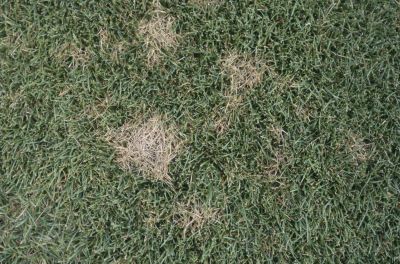Dollar Spot Fungus on Lawns
The fungus gets its name from the brown spots it causes in the lawn. They begin about the size of a silver dollar, but you may not notice them until they grow and spread into large, irregularly shaped areas. The spots resemble those caused by drought, but more water only makes the problem worse. The organisms that cause dollar spot fungus on lawns (Lanzia and Moellerodiscus spp. – formerly Sclerotinia homoecarpa) is always present, but they only take hold and begin to grow when the lawn is under stress. Inadequate nitrogen is a primary cause, but drought, overwatering, improper mowing height, heavy thatch and poor aeration can all contribute to the disease. In the presence of stress, warm days and cool nights encourage rapid fungal growth. Good lawn maintenance is the best way to fight dollar spot fungus. Fertilize regularly using the amount recommended on the fertilizer label. Water weekly in the absence of rain. Apply the water early in the day so that the grass has time to dry before nightfall. Remove excess thatch to allow water and fertilizer to get to the roots. Fungicides can help treat dollar spot fungus, but they are only recommended when good lawn maintenance fails to get it under control. Fungicides are toxic chemicals that you should use with caution. Choose a product labeled to treat dollar spot disease and carefully follow the instructions.
Grass Spider Webs on Lawn
If you see webs on lawn grass despite proper lawn maintenance and without the characteristic brown spots, you may have grass spiders. Grass spider identification is easy because the spiders seldom leave their webs. Look for cone-shaped spider webs in the grass. The spiders like to hide in a part of the web sheltered by fallen leaves, rocks or debris. They quickly run to another part of the web when disturbed, and they can deliver a painful, but otherwise harmless, bite. Grass spiders are beneficial because they catch and eat insects that feed on lawn grass.
